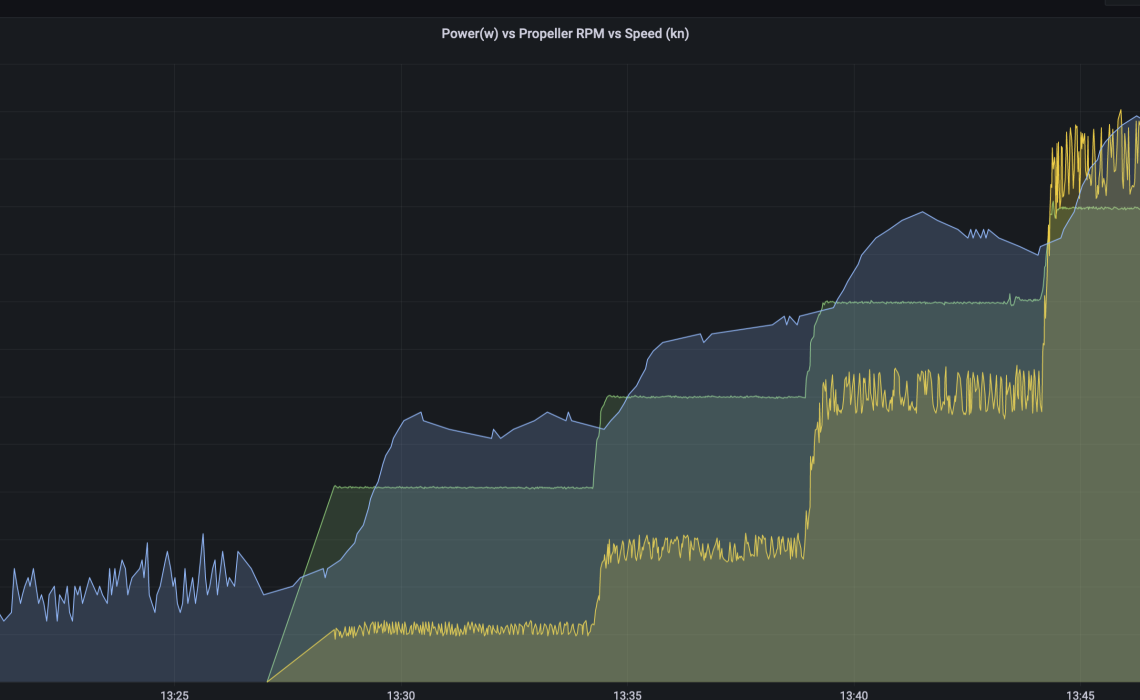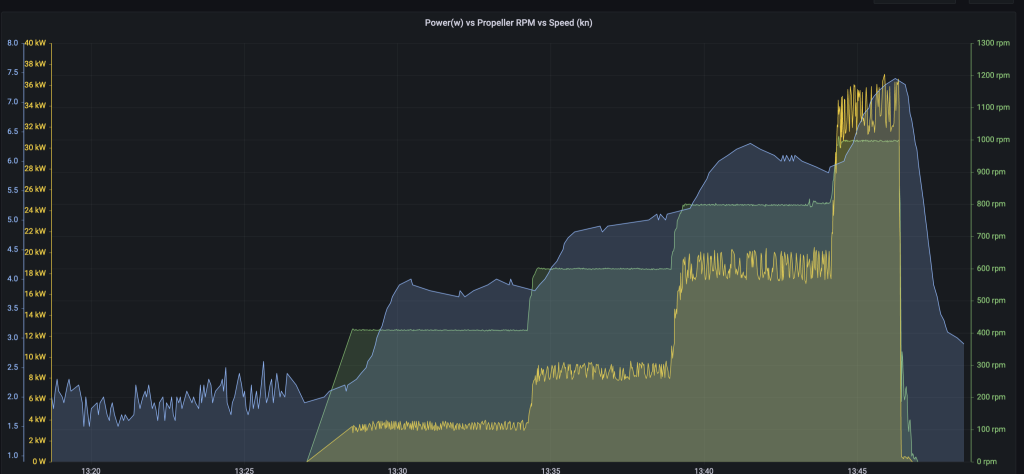

It took many months to find the time and piece all the necessary components together in order to get these 3 variables plotted together on a chart. The only one missing now is solar power generation.
Tech.
- esp32 hardware
- mcp2515 canbus receiver
- can bus
- raspberry pi
- home assistant
- esphome
- influxdb
The dot point version of how this works.
- motor controller for the EV motor has a canbus output. this has a HUGE number of data points that are available from rpm/torque/temperature etc. the canbus from the controller goes into an mcp2515 connected to an esp32. esp32 uses esphome, which sends rpm and kwh data to home assistant, which stores data in influxdb
- mariana ais/gps has a serial connection that goes into a raspberry pi. signal k has a data connection for the GPS info. the emarine MQTT plugin for signal k sends this GPS(speed over ground) info to the mqtt broker which is subscribed to by the home assistant. once in home assistant it gets stored in the influxdb.
Influxdb is where the visual magic happens. This is a specialized db for time sequence data. Each data point that home assistant sends into the influx db has a number of fields but most importantly a unique id, time period and a value. This makes it simpler to make time-based charts to correlate data visually as in the image above.
The next step in this will be to add in the power generation from the solar panels. Home assistant currently reads from the INDININI Victron solar charge controllers for the house battery, BUT is not able to do so from the solar charge controller of the motor battery. This means a shunt needs to be added inline on the solar charge controller for the motor battery that has the capability to output readings for the power that is being generated. Once this is done, a 4th variable will be added to this chart. That will allow a visual representation of how fast to go to ONLY use the power that is generated from the sun.
At the moment we can see the watts that are being made from a small LCD screen on the charge controller. On a summer mid-day, we can make 1300 watts from the 1600 watts of panels. The goal will be to install at least 4kw of panels with a target to generate 3.5kw of power to enable longer motoring on a summer day.
Propulsion options
When setting out to build INDININI and having the desire for an electric motor, there was limited information available for electric motors in boats. Back then Oceanvolt and Torqueedo were around. I received pricing but it was not an option. During 2022 when we sailed from Turkey up to Croatia and then wintering in Tunisia, we used the motor to enter and exit marinas, motor into bays to anchor and sometimes motoring when there was no wind.
The learnings during this time resulted in realizing what a large roll the hull plays when increasing speed. Sure people understand that the faster you go the more fuel used. This is true for boats and cars. The difference when using an electric motor and having the statistics visible is seeing the exponential requirement for power when increasing the speed in very small amounts. This is obvious from the chart above.
During 2023 and 2024 I have reviewed the setup and now looking at options to increase the range. The factors to consider when looking at the requirements for range include things like;
- do you need to motor on a calm day or can you just wait for the wind to blow
- what happens if you need to get out of a storm and how far do you need to go
- if guests are on board and their plane leaves in two days and you need to motor 100 miles fast
- if there is an injury on board and the nearest land is 100 miles away
- the wind is light, the sun is going down and you want to anchor for the night with 20 miles to go
Current setup
This is the current and initial setup when INDININI was built. It met the needs for 8 months of sailing in the Mediterranean. The longest we motored was 80% of the way from Milos to Monenvisia. The seas were flat, the sun was out so we could generate power and we only went 3 to 4 knots speed. We did however motor for 50 nautical miles.
Battery consists of LifePo4 200ah CALB prismatic cells. House consists of a 4p 8s configuration while the motor is 2p 30s configuration.
| Motor batteries wh | 38400 |
| House batteries wh | 20480 |
| wh used at 4knots | 5000 |
| hours at 4knots | 7.68 |
| Charge motor batteries from house batteries | yes at 2500 watts not currently considered in time to motor |
| Solar power | 1400 not currently considered in time to motor |
Option 1 – New diesel motor
This is the default that we could go back to. Drop in a Volvo Penta D2-75hp. The dry weight of the motor is 250kg. The current electric motor weight is 70kg. People are familiar with this and the mounts on the hull in the engine compartment of INDININI are already in place. The cost is not high and the 600L diesel tank in INDININI would allow for ample range. Given that the price of diesel keeps increasing and the cost of LifePo4 batteries keeps decreasing, careful evaluation should be given to this option.
| New motor Volvo Penta D2-75hp | 10,000 |
| House batteries wh | 20480 |
| Motor batteries | 0 |
| Relocate batteries outside of the current diesel tank | |
| Components for new motor, exhaust, controls etc | 5000 |
| Installation |
https://focusmarineoutboard.com/products/Volvo-Penta-D2%252d75-Marine-Engine-Inboard-75-hp.html
Option 2 – New house battery
Take the current house cells and add them to the motor. When building a lithium battery it is important to keep all cells the same. This option would take the house batteries and use them to update the motor battery setup to 3p 30s. I have been very very conservative about the charging settings of both the house batteries and motor batteries. The house has never been charged above 80% capacity and the motor batteries have not been cycled more than 10 times. This would increase the motor battery capacity. It would also require the purchase of new LifePo4 cells for the house. As mentioned the prices have drastically come down on lithium cells. The new setup for the house would be 315ah configured in 3p 8s. The supplier whom I have used in the past now ships to the EU on train and this results in a much faster delivery and reduced cost. They also maintain stock in their Poland warehouse so if at the time of purchase, the cells are in Poland, delivery is even faster and less expensive.
| Motor batteries wh | 57600 |
| New house wh | 24115 |
| New house batteries price | 2160 |
| wh used at 4knots | 5000 |
| hours at 4knots | 11.52 |
| Charge motor batteries from house batteries | yes at 2500 watts not currently considered in time to motor |
| Solar power | 1400 not currently considered in time to motor |
Option 3 – New motor battery
This option would involve a new motor battery that consists of a 4p 30s setup using 314ah LifePo4 cells. This would move the capacity to 120kw which would greatly improve range. The existing batteries could be used for the house and reconfigured to the desired size which would also be dependent on physical space and weight.
| Motor batteries wh | 120576 |
| House batteries wh | 20480 or as much desired up to 57600 |
| New motor battery price | 9400 |
| wh used at 4knots | 5000 |
| hours at 4knots | 24 |
| Charge motor batteries from house batteries | yes at 2500 watts |
| Solar power | 1400 |
Option 4 – Big house battery
This involves part of option 2 where the house batteries would be reconfigured to join the motor battery. The other part of this is to install a new larger house battery. In this configuration, I have targeted to have a total of over 100kw. Under normal operation of using the motor in and out of marinas along with short trips to a bay to anchor, the motor battery would be more than enough. If a longer trip was planned, the house battery could charge the motor battery. The process for this currently exists. The 5kw Victron Phoenix inverter provides power to the 2500watt motor charger. Using this process along with over 1kw of solar would provide ~3500watts to the motor battery.
| Motor batteries wh | 57600 |
| New house wh | 48230 |
| New house batteries price | 4320 |
| wh used at 4knots | 5000 |
| hours at 4knots | 21.2 |
| Charge motor batteries from house batteries | yes at 2500 watts |
| Solar power | 1400 |
Other considerations
- Install a large diesel generator.
- Use a small 2kw gas generator.